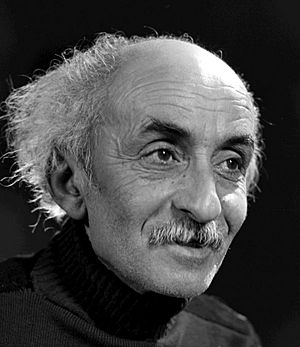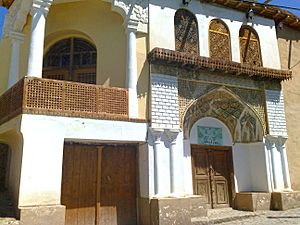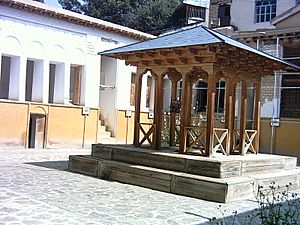Nima Yooshij facts for kids
Quick facts for kids
Nima Yooshij
|
|
|---|---|
 |
|
| Born | Ali Esfandiari 11 November 1897 Yush, Nur, Mazandaran, Qajar Persia (present-day Iran) |
| Died | 4 January 1960 (aged 62) Shemiran, Tehran, Iran |
| Resting place | Imamzadeh Abdollah, Ray (until 2007) , Yush (from 2007) |
| Pen name | Nima |
| Language | Persian |
| Nationality | Iranian |
| Genre | Modernist poetry |
| Literary movement | She'r-e Nimaa'i |
| Notable works | Afsaneh, Quqnūs, The Red Star of Dawn |
Nima Yooshij (Persian: نیما یوشیج), born Ali Esfandiari, was a very important Persian poet. He lived from November 11, 1897, to January 4, 1960. People often called him Nima.
He became famous for a new style of poetry he created. This style is known as she'r-e now (شعر نو), meaning "new poetry." After he passed away, it was also called She'r-e Nimaa'i (شعر نیمایی), or "Nima poetry," in his honor. Many people consider him the father of modern Persian poetry.
Nima died from pneumonia in Shemiran, a part of Tehran. He was buried in his home village of Yush, in Mazandaran Province, just as he had wished.
Nima's Early Life
Nima Yooshij was the oldest son of Ibrahim Nuri. His family lived in Yush, a village in Mazandaran Province, Iran. He was from the Tabarian people and also had Georgian roots from his mother's side.
He spent his childhood in Yush, helping his father on the farm. He often took care of the cattle. As a young boy, he visited many summer and winter camps. There, he met shepherds and traveling workers. He was deeply impressed by stories told around campfires. These stories were about village life and tribal conflicts. These memories stayed with him and later influenced his poetry.
Nima's first school was a maktab, a traditional school. He often skipped school, and his teacher, a mullah, had to find him. The teacher would then bring him back to school and punish him. When Nima was twelve, he moved to Tehran. He then enrolled at the St. Louis School. This was a Roman Catholic school. The school's atmosphere did not change his habits much. However, a kind teacher named Nezam Vafa did. Nezam Vafa was also a well-known poet. He took Nima under his wing and helped him develop his talent for writing poetry.
Life at the Catholic school was very different from the maktab. Also, living in the city was unlike life in the villages of the north. These different experiences sparked Nima's imagination. Even though he kept writing poetry in the traditional styles of Saadi and Hafez for a while, his writing slowly changed. The new ideas he learned began to influence him more and more. This led Nima to try new ways of writing poetry. He started to use new methods that helped him express his ideas more freely. Poems like "Ay Shab" (O Night) and "Afsaneh" (Myth) show this change in his life around 1922.
How Nima Changed Poetry
Nima Yooshij made big changes to Persian poetry. He changed the rhythm of poems. He let the length of a line depend on the idea being expressed. Before Nima, the length of a bayt (a verse) was set by old Persian rules.
He also focused on current problems, like unfairness and suffering. This was different from older poems that often talked about the beauty of a loved one. Nima realized that many readers wanted to connect with heroes and real-life issues. He felt that the old ways of writing limited his ability to share his deep feelings. So, he created a completely new style for modern poetry.
Nima also used personification in new ways. This was different from the usual images of the moon or rose gardens. His unique way of writing brought poetry closer to everyday people. He used natural speech, which added local flavor to his poems.
Perhaps Nima's most important change was his use of symbolism. He built his poems around the steady growth of symbols. This meant his poems could be read as a conversation between different symbols. In the past, only Hafez had tried something similar in his Sufi ghazals. But for Nima, symbolism was key to the poem's structure.
Nima's Published Works
It was not always easy for Nima to publish his poems. In his early years, the government controlled the printing presses. Nima's poetry was seen as too different. Because of this, many of his early poems were not published until the late 1930s.
After Reza Shah's rule ended, Nima joined the "Music" magazine as an editor. He worked with Sadegh Hedayat and published many of his poems there. Only twice did he pay to publish his own works: "The Pale Story" and "The Soldier's Family."
When "Music" magazine closed, the Tudeh Party was formed. Many new leftist publications appeared. Nima, being a radical thinker, was drawn to these new papers. He published many of his important and groundbreaking poems in them.
Ahmad Zia Hashtroudy and Abul Ghasem Janati Atayi were among the first scholars to study Nima's life and works. Ahmad Zia Hashtroudy included Nima's poems in a collection called "Contemporary Writers and Poets" in 1923. This collection featured "Afsaneh" (Myth), "Ay Shab" (O Night), "Mahbass" (Prison), and four short stories by Nima.
Images for kids
See also
 In Spanish: Nima Yushich para niños
In Spanish: Nima Yushich para niños






